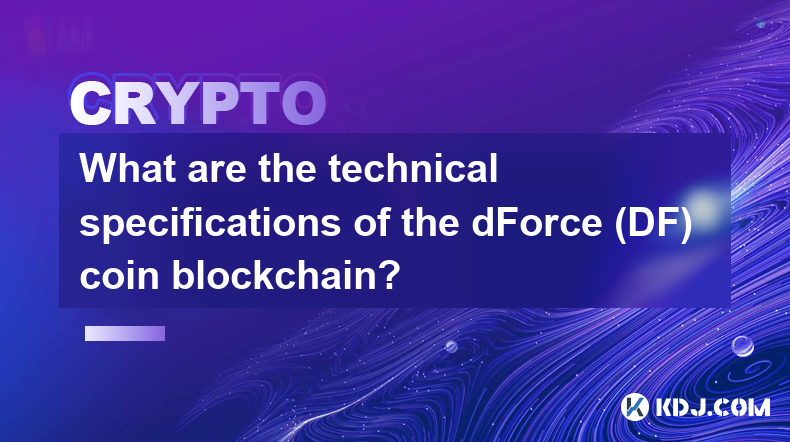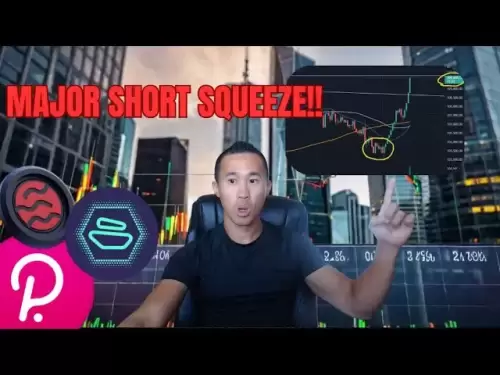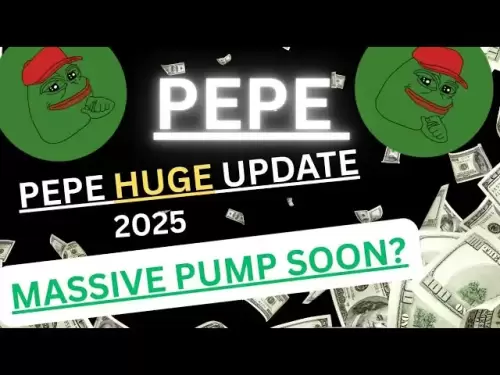-
 Bitcoin
Bitcoin $108,270.9768
2.07% -
 Ethereum
Ethereum $2,489.8066
2.50% -
 Tether USDt
Tether USDt $1.0004
0.01% -
 XRP
XRP $2.2035
0.66% -
 BNB
BNB $661.6608
2.32% -
 Solana
Solana $150.6425
2.13% -
 USDC
USDC $0.9999
-0.01% -
 TRON
TRON $0.2810
0.90% -
 Dogecoin
Dogecoin $0.1645
3.05% -
 Cardano
Cardano $0.5743
4.91% -
 Hyperliquid
Hyperliquid $38.8419
-0.15% -
 Bitcoin Cash
Bitcoin Cash $504.3134
-2.64% -
 Sui
Sui $2.8096
4.35% -
 Chainlink
Chainlink $13.3095
2.21% -
 UNUS SED LEO
UNUS SED LEO $8.9469
0.33% -
 Avalanche
Avalanche $17.9231
3.93% -
 Stellar
Stellar $0.2340
0.74% -
 Toncoin
Toncoin $2.8458
3.21% -
 Shiba Inu
Shiba Inu $0.0...01158
3.47% -
 Litecoin
Litecoin $86.0738
1.94% -
 Hedera
Hedera $0.1507
2.99% -
 Monero
Monero $319.8544
2.31% -
 Polkadot
Polkadot $3.4081
1.95% -
 Dai
Dai $1.0000
0.01% -
 Bitget Token
Bitget Token $4.5645
0.91% -
 Ethena USDe
Ethena USDe $1.0002
0.00% -
 Uniswap
Uniswap $7.2959
5.27% -
 Aave
Aave $272.4623
2.90% -
 Pepe
Pepe $0.0...09680
2.96% -
 Pi
Pi $0.4955
0.78%
What are the technical specifications of the dForce (DF) coin blockchain?
dForce's DF token, the platform's native cryptocurrency, serves multiple roles, including accessing DeFi services, enabling governance rights, and earning staking rewards.
Jan 08, 2025 at 04:09 am

Key Points
- dForce Network Overview
- DF Tokenomics
- dForce Token Utility
- dForce Blockchain Architecture
- dForce Security Measures
- dForce Scalability Solutions
- dForce Development Roadmap
dForce Network Overview
dForce is a decentralized finance (DeFi) protocol that allows users to lend, borrow, and trade cryptocurrencies. It is built on Ethereum blockchain and utilizes the DF token as its native cryptocurrency. dForce aims to provide a comprehensive suite of DeFi services that are accessible, secure, and scalable. The dForce Network consists of multiple smart contracts that govern various aspects of the platform, including lending, borrowing, trading, and governance.
DF Tokenomics
- Total Supply: 1 billion DF tokens
- Initial Circulation: 600 million DF tokens
Token Distribution:
- Team and advisors: 10%
- Investors: 15%
- Ecosystem development: 20%
- Liquidity providers: 25%
- Community: 30%
Token Utility:
- Access to dForce DeFi services
- Governance rights
- Staking rewards
dForce Token Utility
The DF token serves multiple purposes within the dForce Network:
- Access to DeFi Services: DF tokens are required to access and utilize the dForce lending, borrowing, and trading services. Users can deposit DF tokens as collateral to borrow other cryptocurrencies or lend DF tokens to earn interest.
- Governance Rights: DF tokens grant holders governance rights over the dForce protocol. Holders can participate in decision-making regarding platform updates, fees, and other important matters.
- Staking Rewards: Users can stake DF tokens to earn rewards in the form of additional DF tokens. Staking contributes to the security and stability of the dForce Network.
dForce Blockchain Architecture
dForce utilizes a hybrid blockchain architecture that combines elements of both centralized and decentralized technologies. The platform's lending and borrowing functions are executed on the Ethereum blockchain, ensuring immutability and transparency. However, dForce also employs an off-chain matching engine for trading, which enhances scalability and reduces transaction costs.
dForce Security Measures
dForce incorporates multiple security measures to protect its users' assets and maintain the integrity of the platform:
- Smart Contract Audits: dForce's smart contracts have undergone rigorous audits by independent security firms to ensure their robustness and absence of vulnerabilities.
- Multi-Sig Wallets: Sensitive funds and tokens are stored in multi-signature wallets, requiring multiple authorized parties to approve transactions.
- Bug Bounty Program: dForce operates a bug bounty program that rewards researchers who identify and report vulnerabilities in the platform's code.
dForce Scalability Solutions
dForce employs several scalability solutions to handle high transaction volumes and maintain network performance:
- Layer-2 Integration: dForce is integrated with Layer-2 solutions such as Polygon and Arbitrum, which provide faster and cheaper transactions compared to Ethereum.
- Off-Chain Matching Engine: The off-chain matching engine for trading significantly reduces the number of on-chain transactions, improving scalability without compromising security.
- Sharding: dForce plans to implement sharding technology to distribute the network load across multiple parallel chains, further increasing its scalability.
dForce Development Roadmap
dForce has an ambitious development roadmap that includes continuous improvements to its DeFi services, integration with other blockchain ecosystems, and the introduction of new features:
- Cross-Chain Lending and Borrowing: Enable borrowing and lending across multiple blockchains, such as Bitcoin and Solana.
- Derivatives Trading: Introduce a suite of derivatives products to allow users to hedge risks and speculate on the crypto market.
- Ecosystem Expansion: Partner with other DeFi protocols, wallets, and exchanges to expand the dForce ecosystem.
FAQs
What is the purpose of the DF token?
DF tokens are the native cryptocurrency of the dForce Network. They are used to access DeFi services, participate in governance, and earn staking rewards.
How does the dForce off-chain matching engine work?
The off-chain matching engine matches buy and sell orders off-chain, significantly reducing the number of transactions sent to the Ethereum blockchain. This improves scalability and reduces transaction costs.
Is dForce a centralized or decentralized platform?
dForce utilizes a hybrid architecture, combining centralized elements for efficiency with decentralized elements for transparency and security.
Disclaimer:info@kdj.com
The information provided is not trading advice. kdj.com does not assume any responsibility for any investments made based on the information provided in this article. Cryptocurrencies are highly volatile and it is highly recommended that you invest with caution after thorough research!
If you believe that the content used on this website infringes your copyright, please contact us immediately (info@kdj.com) and we will delete it promptly.
- XRP Price Targets $2.40 After Descending Channel Breakout: Is $40 Next?
- 2025-07-03 08:50:12
- All Blacks' Loose Forward Conundrum: New Faces and Familiar Battles
- 2025-07-03 08:30:12
- Bitcoin's Wild Ride: Open Interest, Institutional Bets, and Billions on the Line
- 2025-07-03 08:30:12
- Bitcoin, Strategy, & Profit: MSTR's Crypto Playbook and Trump's Digital Diversification
- 2025-07-03 08:50:12
- INJ Price Bull Rally: Smashing Long-Term Resistance – Can It Last?
- 2025-07-03 09:10:12
- Robinhood, OpenAI, and Wallet History: A Tokenized Tale of Intrigue
- 2025-07-03 09:10:12
Related knowledge

How to customize USDT TRC20 mining fees? Flexible adjustment tutorial
Jun 13,2025 at 01:42am
Understanding USDT TRC20 Mining FeesMining fees on the TRON (TRC20) network are essential for processing transactions. Unlike Bitcoin or Ethereum, where miners directly validate transactions, TRON uses a delegated proof-of-stake (DPoS) mechanism. However, users still need to pay bandwidth and energy fees, which are collectively referred to as 'mining fe...

USDT TRC20 transaction is stuck? Solution summary
Jun 14,2025 at 11:15pm
Understanding USDT TRC20 TransactionsWhen users mention that a USDT TRC20 transaction is stuck, they typically refer to a situation where the transfer of Tether (USDT) on the TRON blockchain has not been confirmed for an extended period. This issue may arise due to various reasons such as network congestion, insufficient transaction fees, or wallet-rela...

How to cancel USDT TRC20 unconfirmed transactions? Operation guide
Jun 13,2025 at 11:01pm
Understanding USDT TRC20 Unconfirmed TransactionsWhen dealing with USDT TRC20 transactions, it’s crucial to understand what an unconfirmed transaction means. An unconfirmed transaction is one that has been broadcasted to the blockchain network but hasn’t yet been included in a block. This typically occurs due to low transaction fees or network congestio...

How to check USDT TRC20 balance? Introduction to multiple query methods
Jun 21,2025 at 02:42am
Understanding USDT TRC20 and Its ImportanceUSDT (Tether) is one of the most widely used stablecoins in the cryptocurrency market. It exists on multiple blockchain networks, including TRC20, which operates on the Tron (TRX) network. Checking your USDT TRC20 balance accurately is crucial for users who hold or transact with this asset. Whether you're sendi...

What to do if USDT TRC20 transfers are congested? Speed up trading skills
Jun 13,2025 at 09:56am
Understanding USDT TRC20 Transfer CongestionWhen transferring USDT TRC20, users may occasionally experience delays or congestion. This typically occurs due to network overload on the TRON blockchain, which hosts the TRC20 version of Tether. Unlike the ERC20 variant (which runs on Ethereum), TRC20 transactions are generally faster and cheaper, but during...

The relationship between USDT TRC20 and TRON chain: technical background analysis
Jun 12,2025 at 01:28pm
What is USDT TRC20?USDT TRC20 refers to the Tether (USDT) token issued on the TRON blockchain using the TRC-20 standard. Unlike the more commonly known ERC-20 version of USDT (which runs on Ethereum), the TRC-20 variant leverages the TRON network's infrastructure for faster and cheaper transactions. The emergence of this version came as part of Tether’s...

How to customize USDT TRC20 mining fees? Flexible adjustment tutorial
Jun 13,2025 at 01:42am
Understanding USDT TRC20 Mining FeesMining fees on the TRON (TRC20) network are essential for processing transactions. Unlike Bitcoin or Ethereum, where miners directly validate transactions, TRON uses a delegated proof-of-stake (DPoS) mechanism. However, users still need to pay bandwidth and energy fees, which are collectively referred to as 'mining fe...

USDT TRC20 transaction is stuck? Solution summary
Jun 14,2025 at 11:15pm
Understanding USDT TRC20 TransactionsWhen users mention that a USDT TRC20 transaction is stuck, they typically refer to a situation where the transfer of Tether (USDT) on the TRON blockchain has not been confirmed for an extended period. This issue may arise due to various reasons such as network congestion, insufficient transaction fees, or wallet-rela...

How to cancel USDT TRC20 unconfirmed transactions? Operation guide
Jun 13,2025 at 11:01pm
Understanding USDT TRC20 Unconfirmed TransactionsWhen dealing with USDT TRC20 transactions, it’s crucial to understand what an unconfirmed transaction means. An unconfirmed transaction is one that has been broadcasted to the blockchain network but hasn’t yet been included in a block. This typically occurs due to low transaction fees or network congestio...

How to check USDT TRC20 balance? Introduction to multiple query methods
Jun 21,2025 at 02:42am
Understanding USDT TRC20 and Its ImportanceUSDT (Tether) is one of the most widely used stablecoins in the cryptocurrency market. It exists on multiple blockchain networks, including TRC20, which operates on the Tron (TRX) network. Checking your USDT TRC20 balance accurately is crucial for users who hold or transact with this asset. Whether you're sendi...

What to do if USDT TRC20 transfers are congested? Speed up trading skills
Jun 13,2025 at 09:56am
Understanding USDT TRC20 Transfer CongestionWhen transferring USDT TRC20, users may occasionally experience delays or congestion. This typically occurs due to network overload on the TRON blockchain, which hosts the TRC20 version of Tether. Unlike the ERC20 variant (which runs on Ethereum), TRC20 transactions are generally faster and cheaper, but during...

The relationship between USDT TRC20 and TRON chain: technical background analysis
Jun 12,2025 at 01:28pm
What is USDT TRC20?USDT TRC20 refers to the Tether (USDT) token issued on the TRON blockchain using the TRC-20 standard. Unlike the more commonly known ERC-20 version of USDT (which runs on Ethereum), the TRC-20 variant leverages the TRON network's infrastructure for faster and cheaper transactions. The emergence of this version came as part of Tether’s...
See all articles

























































































